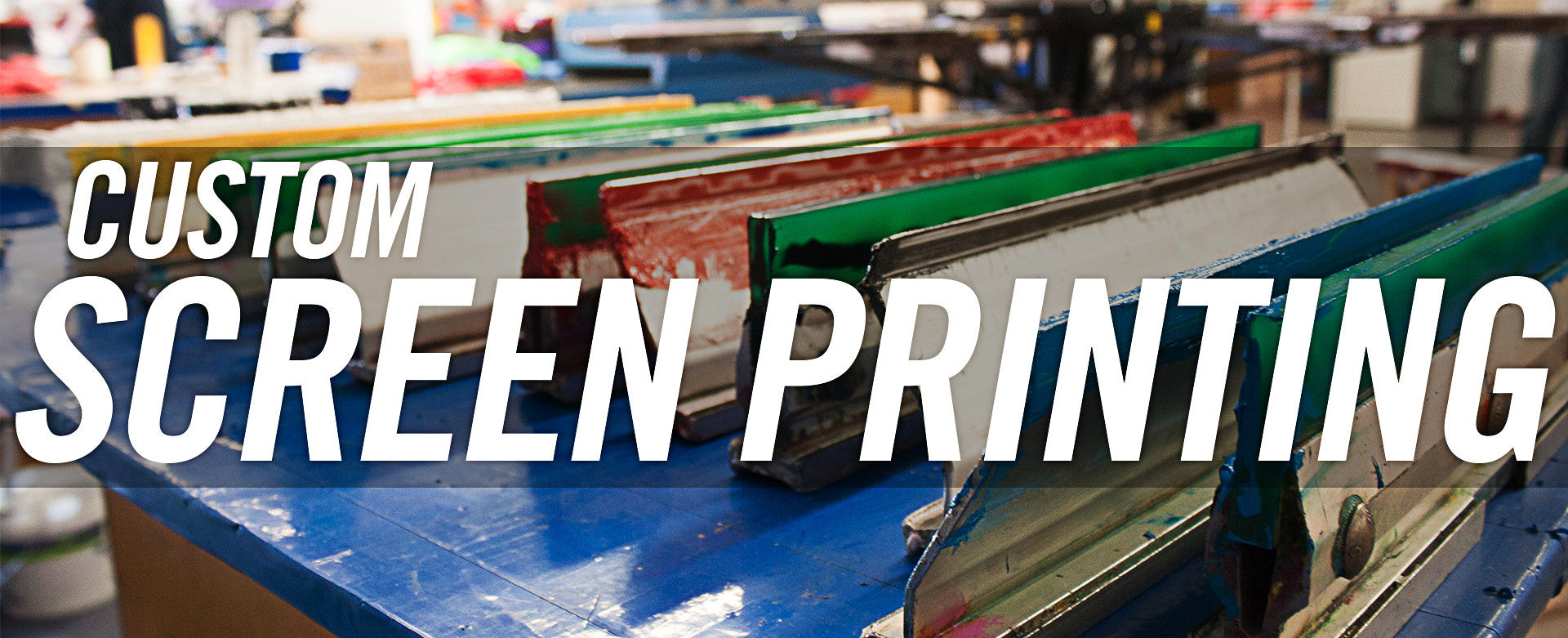Artistic Silk Screen Printing for Limited Edition Prints
Artistic Silk Screen Printing for Limited Edition Prints
Blog Article
Display Printing Uncovered: Everything You Need to Find Out About T-Shirt and Garment Printing Techniques
Screen printing is an interesting technique that integrates art with strategy, providing unlimited possibilities for creative thinking. Prepared to check out the crucial aspects that make screen printing an art form?
The Basics of Display Printing: How It Functions
When you plunge right into display printing, you'll discover it's both an art and a scientific research. At its core, screen printing entails developing a pattern, or display, that allows ink to go through just in details locations (screen printing kit). You begin by picking your style and preparing your display with a light-sensitive solution. As soon as you reveal this solution to light, it hardens, leaving your style as an adverse area.
Next, you'll blend your inks and prepare your printing surface area. Placement the screen over the textile, then utilize a squeegee to press ink with the display onto the garment. This process calls for precision, as you want clear, dynamic prints. After printing, you'll heal the ink with heat, ensuring it sticks to the fabric and lasts via laundries. Each action is necessary, and grasping them will elevate your display printing skills, transforming easy garments into special, meaningful pieces.
Kinds Of Screen Printing Techniques
As soon as you understand the essentials of screen printing, it's time to check out the numerous strategies that can boost your styles. One popular approach is typical display printing, where ink is pushed through a stenciled screen. This technique is excellent for strong, dynamic colors. There's water-based ink printing, which uses a softer feel and is green, however it calls for a different technique to curing.
One more alternative is plastisol printing, recognized for its longevity and dazzling colors, making it a preferred for lots of brands. Experiment with halftone printing to develop slope impacts and elaborate layouts.
Vital Equipment for Screen Printing
To achieve magnificent results in screen printing, having the right equipment is basic. You'll require a sturdy screen printing framework, which holds the mesh that transfers your layout onto the garment. Next off, invest in top notch mops; these are important for using ink evenly throughout the display.
Picking the Right Inks and Materials
When picking inks and products for display printing, you require to consider the sort of ink that functions finest for your task. Think regarding fabric compatibility to ensure your layouts look last and terrific long. Check out environment-friendly ink alternatives to make your printing process much more sustainable.
Kinds of Screen Inks
Selecting the appropriate display ink is crucial for attaining vibrant, long lasting prints that satisfy your job's demands. There are several kinds of display inks to take a look at. Specialized inks, such as glow-in-the-dark or metallic, can add distinct results to your designs.

Textile Compatibility Factors To Consider
Comprehending material compatibility is important for accomplishing premium display prints, especially given that different products react uniquely to various inks. Constantly check your inks on sample fabric to guarantee they adhere properly and maintain shade stability. Additionally, keep in mind that textile weight and texture can affect the last end result, so picking the best ink and material combination is vital for your project's success.
Eco-Friendly Ink Options
Eco-friendly inks are becoming a prominent selection for screen printers who desire to decrease their environmental impact while preserving top quality. When selecting inks, consider water-based inks, which are less unsafe and much easier to clean up compared to typical solvents.
Additionally, look for inks made from sustainable resources, such as soy or vegetable-based choices. By selecting the appropriate inks and materials, you'll not just develop magnificent styles but additionally contribute to a much more sustainable printing process. Make the button, and your prints will mirror your commitment to the environment!
Preparing Your Layout for Screen Printing

File Style Requirements
To guarantee your style looks vibrant and sharp on material, you'll need to pay very close attention to submit layout requirements for screen printing. Start with vector files like AI or EPS, as they can be scaled without shedding high quality. If you make use of raster images, choose high-resolution data, such as TIFF or PNG, preferably at 300 DPI. Stay clear of using JPEGs, as they can lose clarity when resized. Additionally, make certain your style has a transparent history to protect against undesirable white sides on your prints. Ultimately, keep shade modes in mind; CMYK is basic for screen printing, so convert your RGB develops as necessary. By adhering to these standards, you'll establish your art work up for a successful print.
Shade Splitting Up Methods
Shade splitting up is an essential step in preparing your style for display printing, and mastering it can significantly boost your print high quality. You'll require to break your layout into individual colors, as each color requires a different display during printing. This precision not just assures precise shade representation but additionally simplifies the printing procedure.
Resolution and Size
Accomplishing the most effective cause screen printing starts with ensuring your design has the right resolution and size. Preferably, your art work needs to go to least 300 DPI (dots per inch) for sharp, clear prints. If you utilize lower resolution, your final item may look pixelated and unprofessional.
When it involves dimension, consider the dimensions of your print area. Layout your art work to match the last print dimension, preferably developing it in the real dimensions you'll be publishing. By doing this, you'll avoid any unanticipated scaling concerns.
Constantly check your design in both vector and raster formats. Vector graphics can be scaled without losing quality, making them excellent for screen printing. Preparing appropriately will assure your style looks fantastic on every garment!
Step-by-Step Screen Printing Refine
Screen printing is a dynamic process that enables you to develop vibrant designs on various surface areas. To get started, you'll require a display, emulsion, and your chosen ink. First, prepare your display by cleaning it completely. Next, use the solution uniformly and let it dry in a dark area. When completely dry, reveal your screen to light with your layout positioned on it, which will certainly solidify the emulsion where the light hits, producing a stencil - screen printing kit.
After cleaning out the unexposed emulsion, your screen is ready. Set it up on your printing surface area and straighten your garment below it. Pour ink onto the display and use a squeegee to press the ink with the pattern onto the material. Raise the screen carefully and let the print dry. Finally, cure the ink utilizing heat to guarantee sturdiness. That's it! You have actually effectively display printed your design.
Tips for Effective Display Printing Projects
While you're diving into your screen printing jobs, keep in mind that preparation is key to success. Beginning by collecting all your products-- inks, mops, garments, and displays. A tidy office aids protect against unwanted mistakes, so clean prior to you begin.
Following, verify your art work is see here now high-resolution and properly sized this link for your garment. Check your screen for correct exposure and clean it thoroughly to prevent spots. When blending your inks, follow the producer's guidelines to achieve the appropriate consistency.
During printing, apply also pressure with your squeegee for constant results. Do not rush; take your time to validate each print satisfies your standards. After printing, let your garments dry totally prior to managing or packaging them.
Finally, constantly maintain an example of your benefit future reference. In this manner, you can evaluate your progression and enhance your strategies with time. Satisfied printing!

Often Asked Inquiries
The length of time Does It Require To Establish up a Screen Printing Job?
Establishing a screen printing work generally takes about half an hour to an hour. You'll prepare the displays, mix inks, and readjust journalism. The time differs based on complexity and experience, so stay arranged!
Can I Print on Different Textile Enters Making Use Of the Very Same Method?
Yes, you can publish on different textile kinds using the very same method, however you'll require to readjust your inks and settings. Some textiles take in ink in different ways, so experimenting assurances the best outcomes for every product.
What Prevail Mistakes to Avoid in Display Printing?
When display printing, avoid usual blunders like using the wrong ink, ignoring appropriate direct exposure times, or skipping pre-press checks. Always check your arrangement and maintain clean displays to guarantee quality results each time.
Exactly How Can I Appropriately Tidy and Keep My Screen Printing Devices?
To properly tidy and preserve your screen printing tools, you should on a regular basis wash displays with suitable solvents, inspect squeegees for wear, and guarantee all tools are saved dry and dust-free. Uniformity protects against expensive repair services and boosts performance.
Is Screen Printing Eco-friendly Compared to Various Other Methods?
Screen printing can be a lot more ecologically friendly than other techniques, specifically if you make use of eco-conscious materials and water-based inks. By selecting sustainable products and practices, you minimize waste and reduce your influence on the world.
Display Printing Uncovered: Every Little Thing You Need to Know Concerning T-Shirt and Garment Printing Techniques
At its core, screen printing involves developing a pattern, or screen, that enables ink to pass through just in details more info here locations. Position the display over the textile, after that utilize a squeegee to press ink with the screen onto the garment. One popular method is conventional display printing, where ink is pressed with a stenciled screen.When selecting inks and materials for screen printing, you require to take into account the kind of ink that works ideal for your task.
Report this page